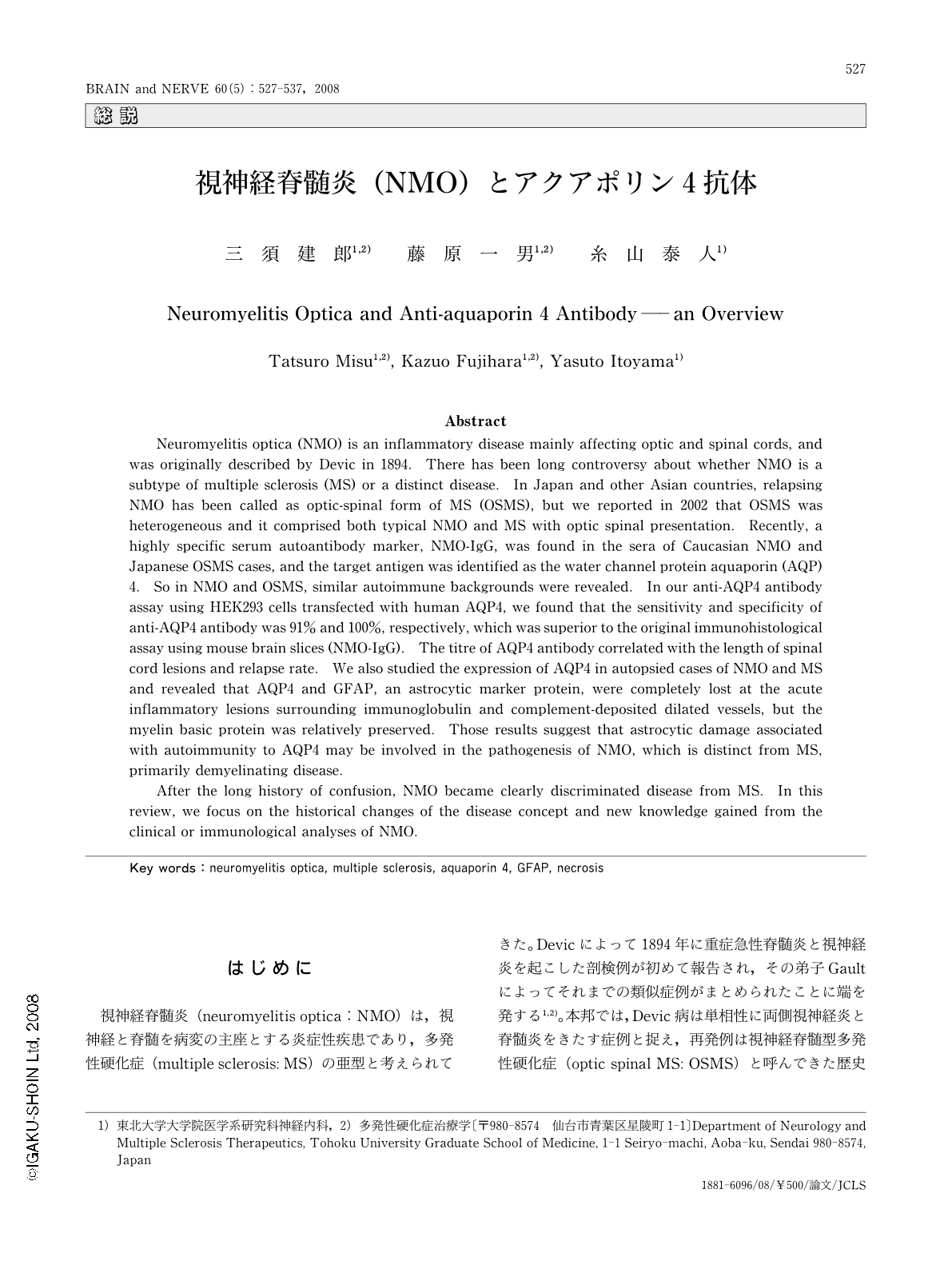Japanese
English
- 有料閲覧
- Abstract 文献概要
- 1ページ目 Look Inside
- 参考文献 Reference
はじめに
視神経脊髄炎(neuromyelitis optica:NMO)は,視神経と脊髄を病変の主座とする炎症性疾患であり,多発性硬化症(multiple sclerosis: MS)の亜型と考えられてきた。Devicによって1894年に重症急性脊髄炎と視神経炎を起こした剖検例が初めて報告され,その弟子Gaultによってそれまでの類似症例がまとめられたことに端を発する1,2)。本邦では,Devic病は単相性に両側視神経炎と脊髄炎をきたす症例と捉え,再発例は視神経脊髄型多発性硬化症(optic spinal MS: OSMS)と呼んできた歴史的背景があるが,その臨床的特異性から両者は長い間古典的MSとの相違が議論されてきた。2004年,Mayo Clinicと東北大学との共同研究によって,欧米人NMOと日本人OSMSの血清中に中枢神経系の軟膜や血管周囲に特異的に反応するNMO-IgGが見出され,2005年にその対応抗原がアストロサイトの足突起に高密度に発現するアクアポリン4(AQP4)であることが報告された。われわれは2006年から2007年にかけて,世界に先駆けてNMOとAQP4抗体に関連する一連の研究を報告した。NMOの剖検脊髄病変における免疫組織学的検討では,本来AQP4の豊富な脊髄灰白質や白質の血管周囲においてAQP4は欠落し,同部位でグリア線維性酸性蛋白(glial fibrillary acidic protein: GFAP)も低下しておりアストロサイト障害が関連すること,またAQP4・GFAPの欠落とは対比的にミエリンは比較的保存されることを初めて報告し,NMO病変はMSの脱髄病変とは異なった病態を有することを明らかにした。当科で行ったAQP4抗体の検討では,AQP4抗体はNMOと診断された患者の91%,再発性視神経炎や横断性脊髄炎を呈したハイリスク群症例の85%で陽性であり,MSや対照群では0%であり,非常に強い疾患特異性を有している。今後は,疾患特異的なマーカーとして必須の検査となるだけでなく,AQP4やアストロサイトの障害から神経系の障害に導かれる病態機序の解明が期待されている。本稿では,その長く混沌としたNMOの研究史からAQP4抗体の発見に至った最新知見までに焦点を当ててみたい。
Abstract
Neuromyelitis optica (NMO) is an inflammatory disease mainly affecting optic and spinal cords, and was originally described by Devic in 1894. There has been long controversy about whether NMO is a subtype of multiple sclerosis (MS) or a distinct disease. In Japan and other Asian countries, relapsing NMO has been called as optic-spinal form of MS (OSMS), but we reported in 2002 that OSMS was heterogeneous and it comprised both typical NMO and MS with optic spinal presentation. Recently, a highly specific serum autoantibody marker, NMO-IgG, was found in the sera of Caucasian NMO and Japanese OSMS cases, and the target antigen was identified as the water channel protein aquaporin (AQP) 4. So in NMO and OSMS, similar autoimmune backgrounds were revealed. In our anti-AQP4 antibody assay using HEK293 cells transfected with human AQP4, we found that the sensitivity and specificity of anti-AQP4 antibody was 91% and 100%, respectively, which was superior to the original immunohistological assay using mouse brain slices (NMO-IgG). The titre of AQP4 antibody correlated with the length of spinal cord lesions and relapse rate. We also studied the expression of AQP4 in autopsied cases of NMO and MS and revealed that AQP4 and GFAP, an astrocytic marker protein, were completely lost at the acute inflammatory lesions surrounding immunoglobulin and complement-deposited dilated vessels, but the myelin basic protein was relatively preserved. Those results suggest that astrocytic damage associated with autoimmunity to AQP4 may be involved in the pathogenesis of NMO, which is distinct from MS, primarily demyelinating disease.
After the long history of confusion, NMO became clearly discriminated disease from MS. In this review, we focus on the historical changes of the disease concept and new knowledge gained from the clinical or immunological analyses of NMO.

Copyright © 2008, Igaku-Shoin Ltd. All rights reserved.


